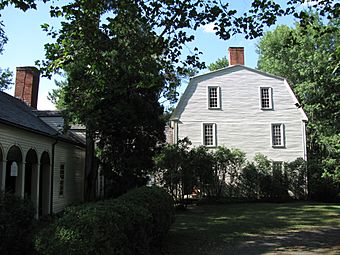Porter–Phelps–Huntington House facts for kids
|
Porter–Phelps–Huntington House
|
|
|
U.S. Historic district
Contributing property |
|

Porter–Phelps–Huntington House
|
|
| Location | 130 River Dr., Hadley, Massachusetts |
|---|---|
| Area | 2 acres (0.81 ha) |
| Built | 1752 |
| Architect | Porter, Moses; Phelps, Charles |
| Architectural style | Colonial |
| Part of | Forty Acres and Its Skirts Historic District (ID100008956) |
| NRHP reference No. | 73000303 |
Quick facts for kids Significant dates |
|
| Added to NRHP | March 26, 1973 |
| Designated CP | May 4, 2023 |
The Porter–Phelps–Huntington House is a special place in Hadley, Massachusetts. It's also known as Forty Acres. This old house is now a historic house museum. It lets you see how a family lived from the 1600s to the 1900s.
The house was built in 1752. The same family lived there for many generations. In the 1940s, a family member decided to turn it into a museum. All the items inside belonged to this one family. Many old papers, like the diary of Elizabeth Porter Phelps, are kept at the University of Massachusetts Amherst. The house became a protected historic site in 1973. It is also a key part of the Forty Acres and Its Skirts Historic District, which was recognized in 2023.
Contents
About the House
The Porter–Phelps–Huntington House is in a quiet, natural area. It sits between River Drive and the Connecticut River. The main part of the house is a two-and-a-half-story building. It is made of wood and has a special roof called a gambrel roof.
Behind the main house, there are several additions. One part has a kitchen and a place for dairy products. Another section has a corn barn and a small living area. There's also an addition to the north with another kitchen. The front of the house has windows placed evenly around the main door.
How the House Grew
The house was first built in 1752 by Moses and Elizabeth Pitkin Porter. It was one of the first houses built outside Hadley's main town center. Later, their daughter Elizabeth married Charles Phelps. They added a larger kitchen to the house.
The house got its current shape in the 1790s. The family added a long section to the south. This included a bigger kitchen for making more dairy products. They also added a second kitchen because the family was growing. A special roof was added to create an apartment for their son, Charles Porter Phelps. However, he never finished it. Instead, he built his own home, Phelps Farm, across the road.
Later Generations
Next, the house went to Elizabeth Whiting Phelps and her husband, Dan Huntington. They got married in 1801 and raised eleven children there. Their youngest son, Frederic Dan Huntington, inherited the house. He was a religious leader in Boston and later a bishop in Syracuse. He used the house as a summer home.
His grandson, James Lincoln Huntington, fully owned the house in 1929. He slowly changed it from a family home into the museum we see today.
Famous Family Members
The Porter family was very important in the Hadley area. Some family members became well-known across the country and even the world. These include:
- Benjamin Lincoln: A major general in the Continental Army during the American Revolution.
- Frederic Dan Huntington: The first Episcopal bishop of the Episcopal Diocese of Central New York.
- Catherine Sargent Huntington: A famous actress.
- Ruth Huntington Sessions: A writer who shared her life stories.
- Roger Sessions: A well-known composer of music.
Slavery at the Porter-Phelps-Huntington House
The Porter–Phelps–Huntington House helps us understand the history of slavery in Western Massachusetts. This includes the town of Hadley. Slavery existed in Hadley from the very beginning of the town. The first four religious leaders in Hadley all owned enslaved people.
Samuel Porter, who was Moses Porter's great-grandfather, bought the family's first enslaved person in 1698. Later, when Moses Porter started his own home in 1752, he enslaved two people named Zebulon Prutt and Peg. Moses Porter bought Zebulon when he was fourteen years old. He paid a large sum of money for him.
When Moses Porter died in 1756, Zebulon and Peg were listed as part of his belongings. Ten years after Moses Porter's death, Zebulon ran away from the house. Elizabeth Pitkin Porter then sold Zebulon to another person. An advertisement described Zebulon and mentioned he might be with a "Squaw," which was a disrespectful term for a Native American woman.
Moses and Elizabeth's daughter, also named Elizabeth, married Charles Phelps in 1770. That same year, Charles Phelps bought an enslaved man named Cesar. He also enslaved a woman named Phillis. Phillis had two daughters, Rose and another Phillis. This meant three generations of enslaved women lived at the house.
After the American Revolutionary War began, Cesar joined the Continental Army. He wrote a letter back to Charles Phelps from Fort Ticonderoga. In his letter, Cesar said:
“I take this opportunity to enform [sic] you that I don’t entend [sic] to live with Capt. Cranston if I can help it and I could be glad if you would send me a letter that I may git [sic] my wagers [sic] and I want to know how all the Talk Do at Home and I Desire you Prayers for me While in the Sarves [sic] and if you Determine to see me I want you Shud [sic] send me my Sock and Buckel [sic] So no more at Present but I Remain your Even Faithful Slave.
- Sezor Philips"
Cesar never came back from the war. It is not known if he died or ran away. Peg had been sold in 1772 but was bought back in 1778. She lived in Hadley until she passed away in 1792.
See also



